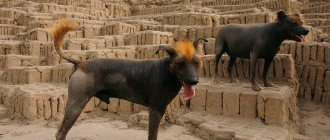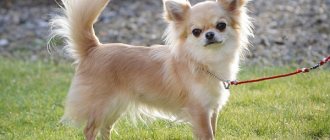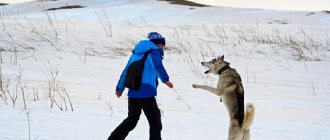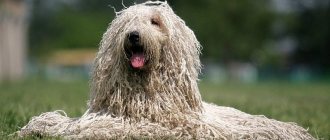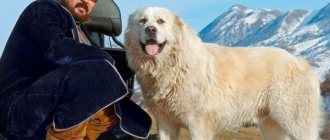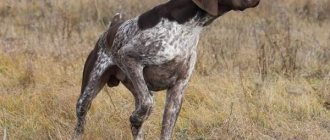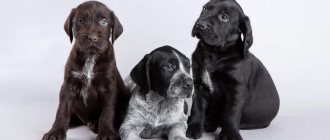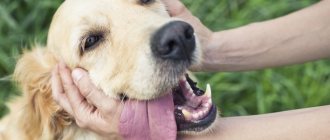Catalburun (Chatalburun), or Turkish Pointer, Turkish hound, is called the fork-nosed dog in its historical homeland for its characteristic and extremely original nose divided in half. This is how the name of this rare breed of hunting dogs is translated from Turkish, the number of which, according to the latest available data, does not exceed two hundred individuals.
- 2 Description of the Catalburun breed
2.1 Appearance - 2.2 Character and psyche of the breed
- 4.1 Training
Story
The first documentary mention of the Catalburuns (or in another transcription Chatalburun) dates back to the end of the 17th century. Even then, the inhabitants of Turkish Cilicia used their excellent sense of smell for hunting. But how the breed originated is unknown. Scientists have different opinions.
Some dog experts believe that the ancestor of fork-nosed dogs (as they are called in their homeland) were the ancient Spanish pointers Perdigero Navarro. According to this version, they came to Turkey back in the 13th century, when Spain was under the rule of the Arab Caliphate. The Cilician peasants liked them and took root in this area.
Common features of Spitz dogs and differences
According to another group, Turkish Pointers were the result of a rare genetic abnormality that unexpectedly took hold and is today considered the hallmark of the breed. According to this version, the ancestors of the Catalburuns are local dog breeds. For several centuries, they were characterized by inbreeding, which became the cause of the mutation - a bifurcated nose.
The special flair inherent in these unusual dogs allows the inhabitants of Tarsus to consider them the best hunters. They are especially indispensable when hunting partridges and other game birds. At the end of the last century, the first club of Catalburun lovers appeared in the province of Mersin, whose members actively advertised their pets. Thanks to this, the breed became known in narrow circles, but the population of forknoses is still small. Even in their homeland there are a little more than 300 individuals.
And outside of Turkey, you can find only a few people who own two-nosed Turkish Pointers. The breed is not registered anywhere and is not recognized by the International FCI Association, but enthusiasts do not give up hope and conduct experiments to consolidate the breed characteristics and develop a unified standard.
Ready for work
Historical reference
It’s worth starting with the fact that all Turkish dog breeds are rare for the modern canine world. You can bet that most of your fellow dog walkers do not know such breeds as Akbash, Kangal, Kars, Malakli, and all these four-legged dogs come from Turkey. With the Catalburun it’s even more complicated; these unique dogs are rare in Turkey itself; even in Ankara, not many people know about the existence of such a breed. Fans of four-legged animals from the northern regions of Turkey will tell you about any national breed, but they will talk about Catalburun as if it were a mystery. What kind of unknown beast is this Turkish Pointer?
The casket opens quite simply. The Pointer is a gun dog for working on water and land. The four-legged animal tracks the game with the help of a keen sense of smell and vision, takes a stance, indicates the direction to the hunter and, after a command, either picks up the bird or drives out the animal. Let's remember the history of Turkey, what did its people do for a living?
At the stages of development BC - ceramics, agriculture, cattle breeding and, of course, hunting, but not guns (there were no guns then). Further, the Hittite kingdom was formed, and after Byzantium, in which the “fishing business” and trade began to flourish. Among the four-legged animals, shepherds, fishermen's assistants and guards were popular - everything is logical. Like all states, Turkey had wars, the struggle for independence and other vicissitudes, but on the economic fronts, in the northern, eastern and western directions, everything remained stable.
There is not much information about the canine history of the South, or more precisely, the southeast. What is known is that more enterprising people lived in Mersin province. Let’s not lie, the flat landscape also contributed to the resourcefulness of the “bipeds”. You already guessed that hunting was developed in this small area, and with it, the Catalburun dog breed was “born”. This is how the Turkish Pointer was developed through the efforts of one region. It is unknown which dogs served as the main ones. All we know is the time period for the development of the breed - approximately four centuries. How the data from the 1650s remained hidden from curious plant breeders also remains a mystery.
Features of the two-nosed breed
The main distinguishing feature of the Catalburun is its bifurcated nose. In some individuals, the nostrils may not touch at all. In fact, the halves of the nose do not bifurcate at all, but do not grow together at the level of the dog’s embryonic development.
According to scientists, this phenomenon is quite often observed during the development of unpaired organs, consisting of two mirror halves. In Catalburuns, such an organ is the nose, so it is more correct to call them dogs with a non-fused nose. It is believed that this anomaly was the main reason for the Turkish Pointer's sensitive sense of smell.
Appearance
In appearance, the Catalburun is a bit reminiscent of the Spanish Pointer, which is not surprising, since they are the closest relatives. But, unlike them, the fork-nosed dog has a heavier appearance. She does not have breed standards, so color and size may vary. Judging by the collective image compiled from the words of a few breeders, the Turkish Pointer looks like this:
- The head is proportional to the body, medium in size. The skull is slightly elongated with a well-developed occiput, the frontal transition is smooth. In profile, the muzzle appears almost rectangular.
- Elongated, drooping ears are set high. They have the shape of a triangle, the tips are rounded. The hanging part of the ears is thin and soft.
- The wide-set oval eyes are covered with heavy lids. The expression of the eyes seems dull due to the overhanging brow ridges. The color of the iris is the most varied, except for blue and gray.
- The nose is wide, with a groove running down the middle, dividing the lobe into two equal parts. The color of the nose depends on the coat, most often black.
- The cheekbones are not too pronounced, the lips are thin, drooping, completely covering the teeth. Jaws with a scissor bite, the number of teeth is standard for dogs.
- The neck is quite muscular, strong, and of medium length.
- The physique is lean, characteristic of all varieties of hounds. The back is straight, not too pronounced at the withers, but with a sloping croup. The lumbar region is short, the stomach is tucked. The chest is wide, oval in shape.
- Limbs are strong and straight. The rear ones are wider apart than the front ones. The hock joint is particularly strong. The paws are compact with tucked toes.
- The tail is elastic and long. Despite the high carriage, the length can reach the hock joint. Often there are fork-nosed dogs with tails docked at 3⁄4.
- The skin is tight to the body, not sagging, without folds. The coat is smooth and short. Any color, but the most common are piebald Pointers with brown spots.
Due to the fact that the breed is not officially recognized by canine associations, there are no exhibition standards. Of the defects, only one is known so far - a bifurcated nose. But this is the so-called “legal” one, since it is the main distinguishing feature of Turkish hounds.
Description
There are subtle differences in the breed standard used in different countries. In the homeland of dogs, Turkey, the standard of the Cynology Federation of Turkey describes the height of the dog from 65 to 78 cm, plus or minus two centimeters.
However, KIF does not distinguish between males and females. Although the standards of other countries are fairly well harmonized with each other, they are not the same as the KIF standard. In the UK, the height at the withers for males should be from 74 to 81 cm, for females from 71 to 79 cm, excluding weight.
In New Zealand, for males the height is indicated from 74 to 81.5 cm, and weight from 50 to 63 kg, and for females from 71 to 78.5 cm, with a weight from 41 to 59 kg. In the USA, this breed is only recognized by the UKC, and the standard describes males from 76 to 81 cm at the withers, weighing from 50 to 66 kg and females from 71 to 76 cm, and weighing from 41 to 54 kg. Turkish Wolfhounds are not as heavy as other mastiffs, which gives them an advantage in speed and endurance. So, they can accelerate up to 50 km per hour.
Their undercoat provides protection from the harsh Anatolian winters and hot summers, while the outer coat protects against water and snow. Such wool allows you to regulate body temperature well, while being dense enough to protect against the fangs of wolves. Differences between the KIF standard and international ones also affected colors. Both official organizations, Cynology Federation Of Turkey (KIF) and Ankara Kangal Derneği (ANKADER), do not consider coat color to be a distinctive feature of the breed.
Black and white spots and longer coats are not considered signs of crossbreeding; the KIF standard is completely tolerant of coat color, and a little more picky about white spots. They are allowed only on the chest and on the tip of the tail, while in other organizations they are also allowed on the paws.
But in other clubs, the coat and its color are the most important features that distinguish the breed from Akbash and Anatolian Shepherds.
It should be short and dense, not long or fluffy, and the color should be grey-yellow, grey-brown or brown-yellow.
All dogs must have a black mask on their face and black markings on their ears. Depending on the standards, white markings on the chest, legs and tail may or may not be allowed.
Ear cropping is done for several reasons, including for protection, since they can become a target for the enemy in a fight.
It is also believed that this way their hearing improves, since it is easier for sound to get into the shell. However, ear cropping is illegal in the UK.
Main characteristics and differences between males and females
In terms of their dimensions, Catalburuns are practically no different from other Pointers. The height of an adult dog can range from 40-63 cm, and the average weight is rarely more than 25 kg. Moreover, it is not always possible to distinguish a female from a male, since they are approximately the same.
| Height at withers | Weight | |
| Male | 40-63 | 18-25 |
| Bitch | 40-62 | 14-22 |
If we talk about character traits, the distinctive features of males and females are not yet known.
Respite
Hyena dog
The second name of this rare breed is the painted wolf. What caused it immediately becomes clear, since such a bizarre coloring in the dog world will not be found anywhere else. This representative of the animal world is clearly a predator, since the teeth are much larger and more powerful than those of other species.
Wild dogs are very socially inclined: they always choose a leader, who is considered an indisputable authority. At the same time, they have a special relationship with their offspring; we still need to look for such caring parents in the dog world. Until the puppies eat, the adults will not touch the food. At the same time, painted wolves are extremely prolific: one litter can have up to 22 puppies.
The spots of each individual have a special, non-repeating pattern. For them, this is analogous to a person’s fingerprint. By coloring, they unmistakably recognize their children, even if years have passed since the separation.
Who can be confused with
Within a breed, dogs are the same and have no interspecies differences. But the Catalburun can be confused with two breeds that also have a forked nose.
Burgos pointer
Despite the fact that the breeds are similar to each other, there are also differences. The Spanish Pointer is stockier than the Turkish, and is not as harmoniously built. In particular, the head is larger relative to the body. There are noticeable folds on the ears, and the set of the tail is much lower than that of the Catalburun. Modern “Spaniards” have a non-fused nose - rather an exception to the rule than a breed characteristic. In each generation, puppies with a forked nose are born less and less often. Perhaps in the near future there will be no trace left of the inheritance of our ancient ancestors.
Andean hound
Despite the external similarity and, possibly, a common ancestor - the Spanish pason, the two-nosed dog from Bolivia has a more aggressive character. This is explained by the fact that its development took place away from humans. Bolivian double-nosed dogs are taller, but only slightly, by 7-8 cm. In addition, the Andean hound does not have such long ears, but the coat, on the contrary, can be of medium length
Purpose
From the very beginning of the breed's existence, these dogs, thanks to their sensitive noses, were unsurpassed hunters. Their amazing sense of smell is still used today during the hunting season. For the pet itself, this is more of a game, which, however, stops as soon as the object of the hunt is discovered. The dog immediately becomes collected and signals the owner about the discovery with the famous stance characteristic of pointers.
The water element is not scary for the Katalburuns. They are excellent swimmers and can stay in water for a long time. Therefore, these dogs are especially valuable in hunting game birds. Who else can rush for prey into a raging mountain stream, if not the Turkish Pointer.
As a guard dog, the Catalburun is practically useless; it has a calm disposition and is not capable of experiencing aggression towards people. But he can become an excellent police dog. His remarkable sense of smell can be used to catch criminals, search for people, and at customs to detect drugs and other prohibited substances. In addition, a fork-nosed dog can be an excellent rescue dog. Its subtle sense of smell helps it look for lost people, find survivors after earthquakes or fires, and since the dog is not afraid of water, it can be useful in rescuing drowning people.
Charming
Moody
The Mudi is a herding dog from Hungary, sometimes called Hungarian Shepherd Dogs. Very energetic, excellent at managing large herds. It is also used as an assistant when hunting big game, in rescue operations or in drug searches. Very smart and unpretentious. Despite its lush “fur coat”, it does not require careful care.
Moody dog jumping
Adult dog of Mudi breed, gray with spots
Adult black Mudi dogs
This breed was known back in the Middle Ages and was highly valued for its herding and hunting qualities. During World War II, the Mudi population decreased significantly, but after that it was restored and even somewhat “improved.” Today it is practically unknown outside of Hungary, but in the USA and Canada there are clubs for lovers of these cute, intelligent and energetic animals.
Character
Turkish Pointers are very active, energetic dogs. Owners often have the feeling that their pets have a perpetual motion machine inside them. This character trait must be treated with understanding and great patience, because in its fussiness, Katalburun can be quite annoying.
In normal circumstances, they are very friendly and peaceful, they get along well with all family members, especially with children, for whom they will become excellent playmates. They treat strangers quite warily, but as soon as a person is introduced into the inner circle, he becomes his best friend. The aggressiveness of the Catalburun is possible only when strangers unceremoniously invade its territory, but this only applies to other dogs.
Catalburun gets along well with pets, especially if he was socialized at an early age. For cats, he is generally the best friend, which cannot be said about feathered pets.
Warning! The Turkish Pointer subconsciously sees birds as objects of hunting, so you should not keep them together.
The best character traits are revealed during the hunt. The dog demonstrates excellent discipline and obedience. In addition, Catalburun, already quite silent, becomes even quieter so as not to scare away his prey, and the moments when he tracks it are probably the best in his life. Having smelled game, the dog practically merges with the surrounding area. She sees and hears nothing except the coveted smell. Bent down to the ground, she crawls almost on her bellies, avoiding all obstacles encountered on her way. But as soon as the desired prey is in its teeth, all the dog’s interest disappears and it begins to look for a new object to hunt.
What do our cats do when we're not around?
Let's continue our excursion through the network and continue to look at the 20 funniest photos with red cats. As a rule, our hustlers climb wherever they want, doing everything they can when we are not there. And we, as a rule, know about this and don’t let them down. Let's see what our furries can do when we turn our backs on them.
Amazing picture! The kitten in the owner’s arms not only snuggles, but sweetly eats everything she prepared for him in the bottle. Apparently, the mother cat is already far away, or has been taken away from her altogether. Thank you to the owner, she feeds her. And thank you to whoever captured it - for such a cool shot!
Rack
It means only one thing - attention, now I’m going to jump and steal something like that. This is the only thing that can be seen from the cat’s pose and eyes.
We see only something else in the expression of his eyes - well, when you (read - the owner) already leave here and, finally, I will do some mischief!
Redhead is clearly not posing here. But he looks like a model! Touches the pineapple leaves so tenderly. Great plan and angle! We see that the cat's movements are careful. But he's not afraid. Maybe you’ve even already tasted pineapple. But there are also saffron milk caps that you only serve vegetables and foreign fruits!
Hey, they caught me! With a fish in his teeth. The evidence is obvious, so to speak. But it’s okay, that’s what the thief looks like in his eyes. Now the owner will turn away and I will fly into the bushes as quickly and unnoticed as possible. This is where I’ll deal with the coveted fish. M-yow, how delicious! What if the cat brings fish to its owner, and we’re just imagining things...
And here we see the same picture - hunting for fish! The fur is already wet. Apparently the cat jumped unsuccessfully. Yes, and by
Or did the owner scare him away? Doesn't matter. The main thing is that there is attempt number... twenty-five? Oh, no one would ruin his hunt!
But we have never seen such a picture. That's it - nose to nose with the prey! I wonder what the cat thinks at this moment, when the rat sniffs him so trustingly? Oh, so these are both pets! But it’s still funny. Although it’s scary, what if the hunter’s instinct kicks in...
Interesting photo
Future hunters
Exceptionally intelligent look That's why she's double-nosed
Adorable puppy
Chatalburun
Training and education
Raising a Catalburun is easy; even the most inexperienced dog owner can handle it. But, if you don’t want unpleasant surprises, there shouldn’t be any lapses in upbringing. You need to start training from the very first days, but you should not force the puppy to serve. A proud dog, at best, will refuse to follow commands, and at worst, it may show aggression that is contrary to its nature.
Training can be done in a playful way. Thanks to his innate discipline, the dog will be happy to complete tasks, and his pride will not suffer, because the owner will play with him. Games with a ball or a stick are good for training the Turkish Pointer, during which he will not only learn to follow commands, but will also throw out an excess of energy, which is simply necessary for such an active dog.
Already from 6-7 months, Katalburun will be useful for hunting, which means training needs to start even earlier. Searching for things or a person is suitable for this. These games will help your dog learn to use his subtle sense of smell and understand the principle of hunting. A puppy who has been trained in this way will not make a mistake when tracking down prey for the first time, and will bring it to the owner, no matter what the cost.
Intellectual toys are also suitable for the development of Katalburun. And to maintain his interest, you can leave a treat, which the dog will receive only when he understands the essence of the game. They should be changed quite often; a cunning and curious fork-nosed dog quickly solves the riddle and soon loses interest in them. Therefore, curiosity must be fueled by novelty.
Canned food for adult dogs
Tibetan mastiff
One of the oldest dog breeds, whose amazing qualities were admired by Aristotle, Marco Polo and many other famous personalities. Moreover, both the physical data of representatives of this breed and their mental abilities evoke admiration.
Since ancient times, Tibetan mastiffs have guarded Tibetan monasteries and were used by local nomads and traders during crossings of the Himalayas. They came to Europe only in the second half of the 19th century and did not receive much distribution here.
Adult Tibetan Mastiff
Tibetan mastiff in rage
Cute Tibetan Mastiff puppies
Physically these are very large dogs. A male Tibetan mastiff can weigh up to 80 kg, and his height at the withers reaches 70–80 cm. Such giants need open air - thanks to their very thick and long hair, they feel comfortable outside even in severe frosts. This is an ideal guard dog. They even prefer to sleep during the day, staying awake at night.
At the same time, raising these animals requires a good understanding of canine psychology - any dog, being poorly trained, becomes dangerous and uncontrollable, and in the case of such a giant, this is fraught with dire consequences. This is probably the reason for the very low prevalence of representatives of this breed.
Feeding
Recommendations for feeding Catalburun are the same as for all Pointers. You can use natural food and industrial feed. But there are also nuances.
You absolutely should not feed puppies dry food, even if you purchased the puppy as a pet. Only correct feeding according to age.
Most breeders do not recommend feeding their pets industrial food. In their opinion, this negatively affects the olfactory abilities of hunting dogs and can cause gastrointestinal diseases. But, if due to some circumstances feeding “natural” is impossible, you need to choose holistic class food with a fully balanced diet.
When feeding natural food, you should know that the basis of the diet is protein. Therefore, it should consist of 80% meat, but to achieve balance, other products are also needed:
- Meat (chicken, lean lamb, turkey, beef).
- Boiled offal (ventricles, heart, lung).
- Sea fish fillet.
- Porridge (rice, buckwheat, oatmeal). If the dog refuses to eat, you can cook it with meat broth.
- Boiled eggs (suitable for daily nutrition).
- Fermented milk products (kefir, cottage cheese, sour cream, yogurt, natural yogurt).
Fruits and vegetables are an essential part of the diet. For pets who willingly eat plant foods, they are given in crushed form as a treat. For dogs that do not recognize such food, it is mixed with minced meat or porridge. A prerequisite is accessible drinking water. It should always be in a separate bowl, clean and fresh.
Dangerous! It is unacceptable to feed Catalburun food from the table. The ban especially applies to salty, fatty, spicy and smoked foods!
Up to 1.5 months of age, puppies eat bitch milk. If the mother has little milk, supplementary feeding with a canine milk replacer is recommended. After weaning, they are fed milk mixed with natural food 5 times a day. Upon reaching 2 months of age, the type of diet is determined and the puppy is gradually accustomed to it. It is recommended to complete the transition to two meals a day by 8 months of age.
A special automatic feeder will help you follow your dog’s diet, which will feed your pet even in your absence. In addition, it is recommended to purchase an automatic drinker for the kit, since the need for water must also be satisfied.
In addition, please note that there are special rules for feeding older dogs. Read about this in a special article.
There is also an almost black color
Nutrition
Catalburuns living in rural areas eat, for the most part, natural, freshly prepared food. These are cereals in the form of porridges, dairy products, vegetables and fruits and, most importantly, protein products of animal origin.
Meat products are the most important component of dog nutrition. It could be beef, lamb, poultry. Animals accept by-products well: heart, lung, especially liver, and so on. In the general diet, meat and everything that contains animal protein should be at least 30%.
Care and conditions of detention
The energy of two-nosed Turkish Pointers is a serious problem if the owner lives in a small apartment. In cramped conditions, the dog simply will have nowhere to splash out his energy. Of course, it is possible, and necessary, to organize a long walk, but this is not enough for an active pet, because Katalburun lives by the principle: “Movement is life.”
In their homeland, dogs are kept on a leash as guard dogs, but these conditions are only suitable for the southern regions. Russian climatic conditions are more severe than Turkish ones, so it is best to keep Catalburun in a private house with an adjacent territory or (the most extreme measure!) An enclosure protected from the cold.
In this case, it is enough to let the dog out into the yard, where it will run and frolic to its heart's content. The owner can combine walking the pet with their own exercise, such as jogging or cycling. In addition, it is necessary to constantly maintain the pet’s health at a high level and carry out hygiene procedures on time.
Eyes
Catalburun has virtually no problems with vision, but still, attention should be paid to the eyes. While walking, there is always a chance that dust will get into them. The consequence of this may be increased tearing, inflammation of the cornea or conjunctivitis. Therefore, after a walk you should wipe your eyes with a damp cotton pad. If there is cloudiness, redness or pus, contact your veterinarian.
Ears
Turkish Pointers, like all dogs with raised ears and thin cartilage, are prone to ear infections, so it is important to keep their ears clean. Once a month they need to be cleaned and carefully inspected for scratches and parasites.
Wool and leather
Since the Catalburun's coat is short, caring for it is not particularly difficult. It is enough to brush your pet once a week with a special brush or velor cloth. During molting, the procedure is carried out more often. This not only relieves your dog of lost hair, but also gives him the pleasure of a gentle massage.
Bathing with shampoo is recommended several times a year. The rest of the time, remove dirt with a soft damp cloth or sponge. But the paws need to be washed every time after a walk, and your pet needs to be accustomed to this from an early age.
Warning! Catalburun is a breed prone to dermatitis. It is necessary to pay attention to any redness and rashes on the skin!
In addition, the fork-nosed dog is susceptible to attacks by skin parasites; after a walk, the fur must be inspected for the presence of ticks, lice-eaters, and fleas.
Claws
In summer, it is recommended to trim nails twice a month. In winter they do not have time to wear off, so the procedure must be carried out every week.
Teeth
Dental care comes down to cleaning and, if necessary, removing tartar. To do this, they use both special means and a soft rag wrapped around the owner’s finger. A puppy begins to be accustomed to this hygienic procedure from the age of 2 months, so that later he does not experience problems with an adult dog.
Have excellent health
Newfoundland
Turkish van
The birthplace of the breed is the island of the same name, which belongs to Canada. It was there that it was formed, and later in England a selection was made and a standard was developed.
In the former USSR, they also did not ignore the beautiful dogs and tried to create their own breed called the diver. The idea failed: attempts to make the dog angry did not lead to anything good: the Newfies did not see the difference between someone else’s and their own and treated their owner aggressively. All that remains of the breed is its name, which is still in use today.
All that remains of the breed is its name, which is still in use.
The Newfoundland has a truly golden character: he is kind, loyal, patient and absolutely not prone to aggression. He readily serves people, devoting himself to the task without reserve.
Just like the Komondor, the Newf can sometimes ignore an order if it considers it inappropriate. Therefore, you should not jerk the diver without a good reason. But if a dog sees that a person is in trouble, then he will not need any instructions: he will make a decision on his own and act according to the situation.
This breed has a real passion for water. Therefore, trips to various bodies of water are real happiness for the dog. This breed will happily make friends with other pets from cats and rats to birds and reptiles.
Innate tact and super intelligence allows the diver to accurately understand the owner’s mood. And if a person is not inclined to communicate, the dog will not bother him.
Newfoundlands are sometimes called man-dogs. They also get offended and withdraw into themselves for a while until the offense goes away. Therefore, you should only punish a diver if there are compelling reasons, and sometimes you may not find them.
Training this good-natured bear is a fairly simple task. Just remember that there is no need to give orders without reason, for the sake of interest or in a raised voice. The Newfoundland is a highly intelligent dog and requires a calm and reasonable owner.
Video: Newfoundland
Health
It is too early to talk about genetic diseases inherent in the breed. However, the owners note that Catalburuns rarely get sick. This is explained by the development of the breed, which occurs in natural conditions, due to which excellent immunity has been formed.
Sometimes double-nosed dogs have mucus discharge from their nostrils. In this case, periodic rinsing of the nose is recommended in case of excessive mucus accumulation.
According to a few breeders, the fork-nosed dog is susceptible to diseases inherent in all Pointers:
- hip dysplasia (can occur even in puppies from healthy parents due to injuries to the hind limbs, a sedentary lifestyle and an unbalanced diet);
- dermatitis;
- breathing problems (the cause may be the special structure of the nose).
They also often experience hormonal imbalances; the thyroid gland especially often suffers from dysfunction. Alarming signs include excessive hair loss, absence or, conversely, a long period of estrus.
Mating, pregnancy, childbirth
Since the Catalburun is a very rare breed, there is a need to preserve its purity. Uncontrolled mating is unacceptable. It should only be carried out under the supervision of the owner. It is advisable for the female to be in heat several times; for males, the optimal age is 1.5 years. Dogs mated at an early age will produce weak and sickly offspring.
Mating is carried out on the male's territory; while at home, the female can be capricious and not allow him to come near her. It is not advisable to feed dogs before mating; it is better to let them run freely and at the same time get to know each other. To consolidate the result, a control mating is carried out the next day.
The number of newborn puppies rarely exceeds 2-3. Until the age of two months, they are kept next to their mother, after which they are transferred to a separate place or given to a new owner. It is necessary to transfer the puppy bitch to special feeding to obtain a sufficient amount of milk.
Stabihun
This is a Dutch breed of hunting dog with a characteristic hereditary skill - to freeze in a characteristic stance when detecting game. Actually, the name of the breed is translated as “standing nearby.”
Stabihoun puppy, photo
Adult Stabihoun dog
Photo gallery: Running Stabyhune
Stabyhouns are small, calm, extremely intelligent and affectionate dogs. They love children very much. They are excellent hunters of all kinds of pests, so they are valued on the farm. However, today they are a very rare breed - they can only be found in the Netherlands and, in very small quantities, in northern European countries.
Advantages and disadvantages
If we talk about the advantages of the breed, they are all obvious:
- Catalburuns are very disciplined and balanced dogs. In any situation, they will not lose their heads, but will carry out all the owner’s commands.
- An empty dog is not about them. In everyday life and when hunting, Turkish pointers are quite silent. Their loud barking can only be heard when their territory is encroached upon. And then, the pet will subside as soon as the threat disappears.
- Catalburun is not only an excellent hunter, but also a companion. He will easily make friends with all family members and will tolerate even the most capricious child.
The downside is that such a pet is not suitable for everyone. First of all, this is a gun dog and will not be a soft plush toy. The energetic temperament of a pet will cause trouble for quiet, calm, and elderly people. Before adopting a puppy, you should carefully weigh the pros and cons. If you are not ready to provide your dog with the necessary level, take it out hunting, train it and engage in outdoor games, you should not take it. This will only ruin the life of both yourself and the dog.
Turkish Kangal
In Turkey there is a breed of dog with incredible strength and power and it is called the Turkish Kangal.
The Kangal dog is a very ancient Turkish herding dog. Turkish cattle breeders love their assistant very much, because he can easily maintain discipline in the herd and protect his herd from various predators. A dog of this breed is very calm and not aggressive like other Turkish breeds. Kangal will only release his teeth when necessary. This dog is quite strong and energetic and you can’t work all day without getting tired.
The Kangal dog is not a pet at all. Without a doubt, he loves his owner and loves to spend all his time with him, but you should understand that he is mainly a working dog, and only then a pet. Since ancient times, the Kongal has developed a desire to work and is unlikely to be happy lying on the couch all day and idle. Without work, your pet may begin to actively misbehave and you will not like it very much.
Keeping a Kangal in a city apartment is like keeping a dog in a cramped cage, so it needs a lot of space. The Turkish Kangal dog is extremely distrustful of people unfamiliar to him, and these are people with whom the owner has not introduced the dog, so the dog is ideal for protection; besides, it will dispel its instinct in a very interesting way. The most important thing when training is to let the dog understand that you are in charge here and no one else.
Appearance
The Kangal dog breed looks quite good, a tall dog of a strong build, with a strong body, powerful neck and stable limbs. The height of the dog reaches 70 - 90 cm, weight from 35 to 75 kg. The coat of this dog breed is thick and short, with a thick undercoat.
The color of the kangal can be gray-yellow, gray-brown or brown-yellow. Such a dog cannot have a white color. The Kangal's movements are free and energetic; when walking, the Kangal holds its head and neck in line with its back, which may make it seem like the dog is not walking, but sneaking.
Personality The Kangal is a dog with an independent character. Such a dog obeys the one it respects - and they only respect their owner or the one in whom they feel inner strength. It is best not to use physical violence in raising a Kangal - it can become angry and you will not love such a dog. If you want to achieve something from your dog, then you need patience and insistence to understand how to teach your dog simple but very important commands.
You also need to let the dog communicate with other dogs and people so that it is calm and manageable. The dog does not experience aggression towards children, and even allows itself to be caressed and stroked; it can play various games with them. But you also need to be careful, since the dog is not small and can touch something and drop it, which you will not like at all.
Kangal is not a domestic dog
Kangal dog - the price of which is quite satisfactory from 15 to 25 thousand rubles. Many people ask why the Kangal cannot live at home. Firstly, this is a fairly large breed of dog. Secondly, she is very energetic and needs more space and fresh air. Thirdly, its real purpose is to herd livestock. She has been doing shepherd work for a very long time, and if she has nothing to do, then she may simply start misbehaving.
Proper care The Kangal dog breed is simply ideal for guarding your home. It does not require any incredible care and can easily tolerate both heat and cold. It’s best not to keep him on a leash; try to provide him with freedom in the territory of your home.
Feeding your dog is an important part of caring for your dog. It is best to prepare nutritious food for your dog from meat or fish; it is also good to give vegetables and those foods that you eat yourself. As for purchased food, the amount of dry dog food should not exceed the dose indicated on the label of the food bag. Advance dog food is currently considered the best and highest quality product. Share post
Interesting Facts
Despite the fact that the breed has been little studied and is unknown outside Turkey, there are already many interesting rumors about it:
- If you call a dog Catalburun in its homeland, there is a risk of remaining misunderstood. There this breed is called Chatal-burun, which translates as a fork-nosed dog.
- And the first and, so far, only compiler of a description of the amazing breed was Mustafa Kemal, a modest biology teacher from an Anatolian school. He and his students conducted a comparative analysis of 80 individuals and recorded the results. He submitted an official request for recognition of the breed to TKF (Turkish Kennel Association), but received no response.
- Catalburun has no equal in hunting for turach. These birds from the pheasant family, thanks to their plumage, can camouflage themselves as a stone or a hummock. In the hunting environment, they are considered the most difficult game. The Turkish Pointer, using its superior scent, easily detects these birds and places them on the wing.
- In fact, the Catalburun's subtle sense of smell does not depend on the bifurcated nose. Another organ responsible for this in dogs is the vomeronasal organ, located in the front part of the palate.
- A dog's repulsive appearance plays a big role in a dog's unpopularity. Even in Turkey it is considered unattractive, despite the fact that the Catalburun is a local breed.
Many dog handlers believe that the fork-nosed dog comes from Ancient Greece and that it was the progenitor of the Spanish Pointer, and not vice versa.
How to choose a puppy
You need to choose the most active and inquisitive puppy from the litter. You can put a bowl of food or throw something that jingles, and take the puppy who runs up to examine the unfamiliar object first. But first, you should also visually inspect your new pet. A wet nose, smooth shiny coat, clean eyes and ears are the key to health and good living conditions. If possible, you should look at the parents to ensure the purity of the breed.
Dog breed Russian Greyhound, character and what it looks like, what colors are acceptable
Norwegian Lundehund
This beauty first appeared on the coast of Norway. Its peculiarity is that it has a unique anatomical structure, which allows it to climb rocks and caves and walk along narrow paths.
Dogs are kind and friendly, friendly with children, and love to frolic. They are suitable for living outside the city, as they need freedom, training and long walks.
Such a pet costs about 20 - 30 thousand rubles.
Where can I buy and at what price?
Buying a two-nosed puppy can be a long and problematic task; there are no nurseries where this breed is bred yet. To purchase, you will need to visit Turkish Tarsus or contact TKF. Due to the unpopularity of the breed, the price for Catalburun puppies is not too high, approximately $300 or 2000 Turkish lira. But outside of Turkey, where the number is only a few units, the price can be exorbitant. After all, there are more people who want to buy an exotic pet than there are puppies in the litter.
